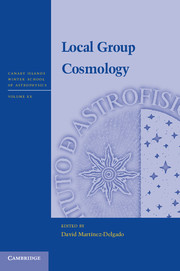Book contents
- Frontmatter
- Contents
- List of contributors
- List of participants
- Preface
- Acknowledgments
- Abbreviations
- 1 The formation of the Milky Way in the CDM paradigm
- 2 Dark matter content and tidal effects in Local Group dwarf galaxies
- 3 Notes on the missing satellites problem
- 4 The Milky Way satellite galaxies as critical tests of contemporary cosmological theory
- 5 Stellar tidal streams
- 6 Tutorial: The analysis of colour-magnitude diagrams
- 7 Tutorial: Modeling tidal streams using N-body simulations
Preface
Published online by Cambridge University Press: 05 November 2013
- Frontmatter
- Contents
- List of contributors
- List of participants
- Preface
- Acknowledgments
- Abbreviations
- 1 The formation of the Milky Way in the CDM paradigm
- 2 Dark matter content and tidal effects in Local Group dwarf galaxies
- 3 Notes on the missing satellites problem
- 4 The Milky Way satellite galaxies as critical tests of contemporary cosmological theory
- 5 Stellar tidal streams
- 6 Tutorial: The analysis of colour-magnitude diagrams
- 7 Tutorial: Modeling tidal streams using N-body simulations
Summary
Background
One of the unresolved problems of modern astrophysics is how the galaxies we observe today were formed. The Lambda–Cold Dark Matter paradigm predicts that large spiral galaxies like the Milky Way formed through the accretion and tidal disruption of satellite galaxies, a notion previously postulated on empirical grounds from the character of stellar populations found in our Galaxy. The Local Group galaxies are the best laboratory in which to investigate these galaxy formation processes as they can be studied with sufficiently high resolution to exhume the fossils of galactic evolution embedded in the spatial distribution, kinematics, and chemical abundances of their oldest stars.
Scientific rationale
This “Galactic archaeology” has recently undergone an unprecedented revolution, brought about by the spectacular increase in the quality and quantity of observations of Local Group galaxies using large-aperture ground-based telescopes and the Hubble Space Telescope, and with the advent of the first large-scale digital sky surveys (such as SLOAN and 2MASS) at the start of the twenty-first century.
The possibility of contrasting these observations with results on a small scale of cosmological simulations has drawn the attention of cosmologists towards the study of Local Group grand design galaxies and their satellites, thus giving rise to new lines of research that have involved numerous resources and a considerable observational and theoretical effort. The disagreement between the results of simulations and observations has also given rise to serious controversies among observers and theoretical cosmologists and is still the subject of active debate in the international community.
- Type
- Chapter
- Information
- Local Group Cosmology , pp. xiii - xivPublisher: Cambridge University PressPrint publication year: 2013

